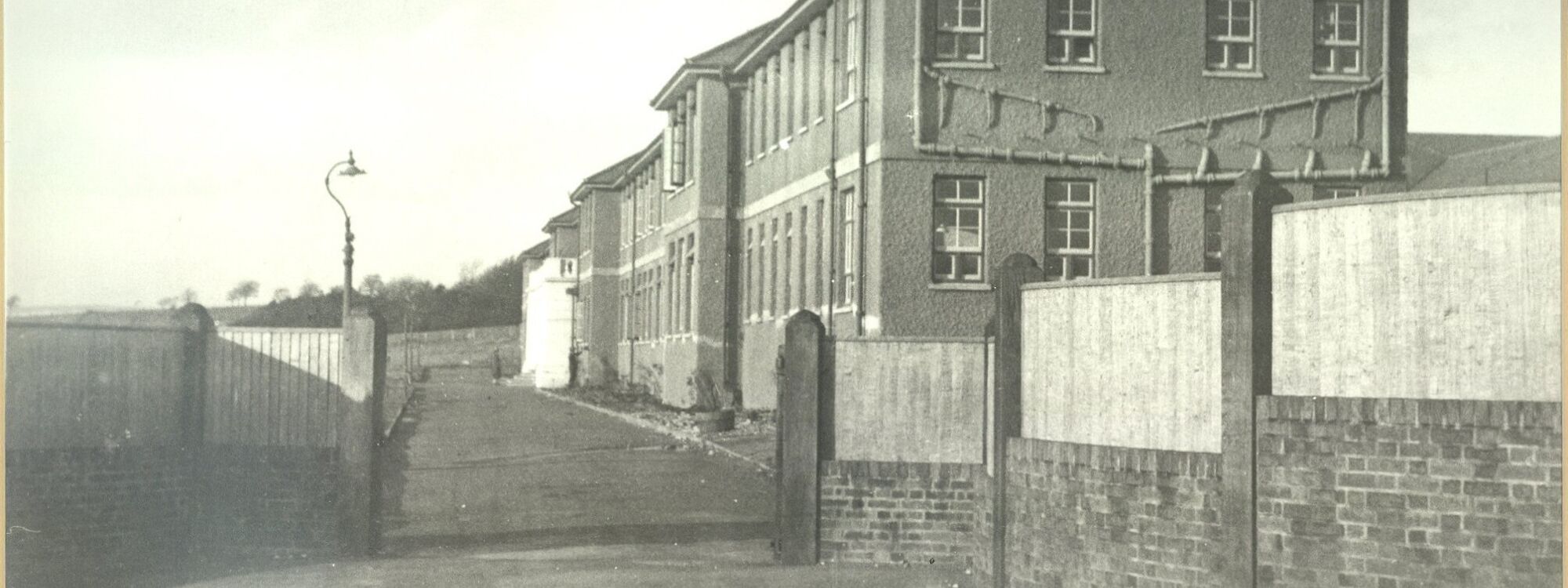
Varndean School has a proud history and has undergone many changes to bring us to the place we are now. It started life as York Place School in the centre of Brighton in 1884. It was the inspirational and determined headteacher, Miss Ethel Ellis (Headteacher 1909-1937), who had a new modern vision for girls' education and brought the school to its current site in 1926. Since then the school has evolved into a vibrant and diverse co-education comprehensive school with a population of over 1400 students which represents the community we serve.
We have several notable alumni and are always keen to hear news of our students past and present. Please use the alumni registration form at the bottom of this page if you would like to stay in touch and/or share your stories.
Alternatively please contact our archivist judithhodson@varndean.co.uk with your memories and stories of Varndean School.
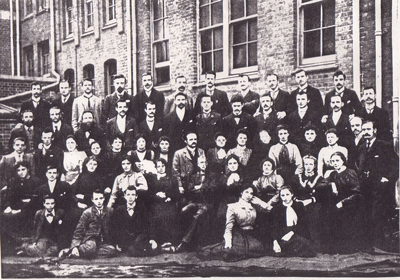
Staff in 1900
The new headmistress, Miss Ethel Vera Ellis, MA, had professional qualifications very different from those of her predecessors. Born in New Zealand, educated in London and at Newnham College, Cambridge, she had a degree in Medieval and Modern Languages and a postgraduate teaching certificate. Well-travelled and with an active devotion to the arts, she was eager to extend the privileges of her own education to as wide a range of girls as possible. She came to York Place after teaching at Hulme Girls' Grammar School and immediately set about widening the interests of her pupils, urging the improvement of the school buildings - partial electric lighting was installed, corridors and the staff-room redecorated - and re-organizing the form-structure of the school. The system of pupil-teacher training had been phased out as the numbers of local training colleges had grown, so that all the girls now staying on after the age of sixteen were in the Lower and Upper Sixth forms, following the Senior Cambridge examination courses, some hoping to matriculate and go on to degrees, others to gain entrance to teacher-training colleges. The new system gave much greater opportunity for Advanced courses and it was obvious that more highly qualified staff were required. Miss Ellis, a lady of exceptional persuasive powers, soon convinced the Governors that the school urgently required a Second Mistress and, a year after her own appointment, she was joined by the deputy of her choice, Miss H J Strange, BA, an Oxford history graduate with whom she had taught previously. Theirs was a partnership which was to dominate the development of York Place/Varndean for the next twenty seven years. In 1911 Miss Marshall, a London mathematics graduate, and, soon after, Miss Nicholson, with a London degree in English, joined the staff.
The official records from this period are brief but, speaking at the Old Girls' Association Dinner in 1954, Miss Ellis herself recalled,
The School was badly equipped with labs, and we could not do much science. We had the Hall only one day a week, so we could not do much singing or physical exercises. We had no Latin and no German, not much in the way of books, no library, no proper playground, not even proper hockey sticks - but art had an art room and Miss Constable and how thankful we were for that!
Within weeks of her arrival, Miss Ellis organized a gym club ("at all drill lessons in future the girls are to wear their hair plaited"); hockey and cricket played on the land acquired by the Education Committee at the end of Surrenden Road (where the Dorothy Stringer school now stands) took on a new energy in spite of the "undersized and sloping pitch", real hockey sticks replaced the ash walking sticks previously used and real pads were made available; the swimming competitions blossomed into a full-scale annual swimming sports at North Road Baths (in 1912 one York Place girl was a reserve in the women's Olympic team); Sports Days and Drill Displays attended by parents were organized and, in 1913, York Place took part in the first South Eastern Counties Girls' Public Schools Lawn Tennis League Tournament. In all these activities Miss Ellis and Miss Strange were active participants, being keen hockey and tennis players themselves.
In 1910 Miss Strange initiated a Sixth Form Debating Society which held its earliest meetings in the Prefects' room, a little attic at the top of the Annexe, "with a smoky fire whose warmth could not have been the inspiration of the keen debates". There were frequent visits to exhibitions, the theatre, concerts and lectures whilst the girls and staff put on a wide variety of entertainments - dancing, singing, plays in French and English. (At this time the most widely known of all York Place pupils was in the School - did Evelyn Laye, one wonders, gain her first stage experience here?)
All girls now wore school uniform - the three-box-pleated navy serge tunic and "butcher" blue blouse "which were never removed in school hours, not even for our drill lessons" - and the red drill-stripe for good work and the school badge for games colours were introduced and proudly worn. Less popular were the thick black stockings and the straw boater with coloured hat band. The navy knitted cap with lighter blue stripe and badge introduced by Miss Ellis was welcomed in 1912 but less enthusiastically worn a generation later. Many pupils from this period remember the punishment system: names of offender and offence were entered in a Disorder Book and the "black mark" incurred could only be redeemed, after a period of two or three weeks, at an interview with the Headmistress. The most serious - and persistent - offence was communicating with the York Place boys in the adjacent building. In school time, they were supposed not to exist! But the shared Prize Giving continued, the one in 1913 being particularly memorable, with all the girls dressed in white.
The First World War
Led, we struck our stroke.
This exhilarating and happy progress was brought to an abrupt, though temporary, halt on 23rd November 1914. Without warning, Miss Ellis was summoned to the Education Office to be told that the school premises were required for an Indian Military Hospital and must be vacated within twenty-four hours. She at once returned to the school to supervise the removal (by the Boys' Brigade!) of all the school furniture to the forecourt. She herself rescued the pictures and took them home for safe-keeping. In pouring rain, books, desks, equipment and half-made toys for the Christmas collection were piled high. It poured all the next day too, as the girls carried their possessions to their new "school" in rooms scattered through the nearby Technical College and, for the very youngest, a room in the Police Institute. Surplus desks and equipment were stored in the emptied North Road Baths, some of it not to appear again until the war was over. The biology department's skeleton did not re-emerge until 1926!
Eleanor Horsley, who was in the Sixth Form at the time writes sympathetically of the problems facing Miss Ellis and her staff as they spent the next week in an heroic struggle to re-arrange classes, timetables and accommodation. (In 1940, as Headmistress of Balfour Girls' School, Eleanor suffered similar problems when her school, too, was commandeered.) Yet work was scarcely interrupted and although, in Miss Strange's words, “some things - parties, form-prizes, inter-school matches and tournaments - had to be given up", the girls involved themselves with equal enthusiasm in war activities. They knitted socks, rolled bandages, made jam, "adopted" a prisoner of war and sent him a weekly food parcel and tried - for an unspecified, but certainly useful purpose - to collect a million tram tickets. They dug and worked allotments beside the newly acquired flat hockey pitch where Balfour schools now stand and won an Honourable Mention at the Allotment Holders' Show, When a serious influenza epidemic hit Brighton in 1917, the York Place girls escaped almost unaffected because the Headmistress and the caretaker sprayed every room every day with disinfectant. Time could not be spared for mass illness of girls or staff.
Work certainly did not suffer. The high standard of achievement in examinations continued and was reflected throughout the school. In 1915 one Sixth Form group pioneered an Advanced Course offering "the solid and coherent study of a period in the language, literature and history of at least two countries". For this purpose the learning of Latin was introduced and a special grant for the necessary books was made by the Board of Education, Even in the adverse conditions of wartime, the Library began to grow. In 1917 the Board of Education and the Universities at last agreed on a new examination system which would facilitate entry to the professions and degree courses. The School Certificate examination to be taken at a minimum age of fifteen, covered subjects from at least five groups -history or geography; mathematics or science; English language and literature, a modern language and one other such as art, music, crafts or a classical language. Pupils could, of course, take more than five subjects, but a minimum of five passes was necessary to gain a certificate, A "Credit" mark in each of the five basic groups gave exemption from university matriculation requirements. At a more advanced level, the Higher School Certificate required three subject passes. Credit in three subjects plus another taken at "subsidiary" level gave exemption from the universities' Intermediate Examination and opened the way to a degree three years later. This system, with minor adjustments, lasted until the introduction of 0 and A level GCE examinations thirty years later. In 1917 fewer than ten per cent of the age group across the country would take even the minimal School Certificate, with an even smaller proportion of girls, but the way had been opened to the wide-ranging education that Miss Ellis and her staff were eager to provide.
The Modern Studies Advanced Course already taken by Sixth Form girls was easily converted to a Higher School Certificate course: English, History, French (Miss Middleton joined the staff in 1917) and Latin; but lack of fully qualified teachers, laboratories and equipment made it impossible to organize an equivalent Science Sixth Form immediately. Even before the war was over these deficiencies merely reinforced a plan Miss Ellis was quietly developing - the building of a new school.
Then the cloud-rift broadens
At last peace returned. In 1919 the Upper School moved back to the old York Place building whilst the younger girls remained in part-possession of the Technical College and a house in Hanover Crescent used for craft lessons. In 1920 the first Science Sixth - two girls - began work on the Higher Certificate course and in the following year nine Lower Sixth girls joined them. This made just enough for a Science Sixth hockey team! Ruth Davey, one of the original science group, writes,
The VI Sc. form room was a funny little room into which we squeezed the eleven desks plus the staff desk for our form-mistress. Unfortunately she was large and only just fitted in between the desk and a cupboard of the under-the-stairs variety.
Obviously there was no room for an expanding Science Sixth and already practical work and lessons had to be carried out at the Technical College.
In the immediate post-war years girls went in increasing numbers to university, training college, art school, to careers in the Civil Service (in 1923 one girl was placed first and others fourth and fifth in the Clerical Class examinations), to secretarial colleges, nursing training and to more unusual careers such as horticulture and poultry farming. New members of the increasingly highly qualified staff included Miss Chandler, Miss Craig and Miss Turner. School clubs and activities flourished: a Literary Society was started, the School formed a branch of the National Council of Women, sometimes inviting parents to its lecture-meetings; charitable causes continued to be most generously supported; piano recitals were given by visiting performers, and the school choirs and dramatic groups gave "delightful entertainments" - as did the staff! Educational films were frequently shown and a fund for the purchase of a gramophone was started.
Many Varndeanians will remember Miss Ellis speaking of her hopes and dreams for the new school; how, when she used to bring girls to play hockey on the Balfour pitch, she would look up to the farmland at the top of the hill and imagine it as the site of a splendid new building. In her report for the school year ending in July 1923, after years of planning and persuasion, she was able to say,
In July last the sanction of the Town Council was given to the erection of new school buildings, on a beautiful site on the edge of the Downs, and what this will mean to the girls of Brighton in health and inspiration, it is not easy to over-estimate. Nor can the advantage to the School of once more being under one roof for the first time since 1914 be overrated. It will mean a concentration of energy and a unity in the school life which will bring vigour and stimulus.
In that same year the energy and vigour which already existed had brought record examination results: forty-one School Certificate successes with thirty-four distinctions and thirty exemptions from London Matriculation; twelve Higher School Certificates with four distinctions and two exemptions from the London Intermediate Arts examination. To crown this achievement one sixth-former was awarded an open scholarship to Oxford. And a last link with the Higher Grade School was broken: Miss Hudson who had joined York Place in 1885 retired in 1923 - a record of service surpassed by only one future member of staff.
On the 22nd October, 1924, the Foundation Stone of Varndean was laid; in December the Old Girls' Association (see Appendix) celebrated its twenty-first anniversary and, in July, the first number of the Varndean Chronicle was published. Forty years, in which the education of girls in Brighton had made more progress than in all previous time, were completed.
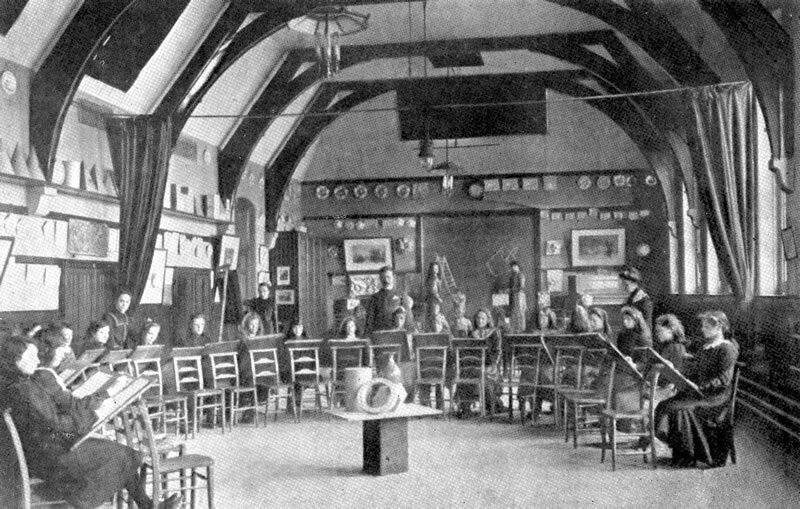
Art room 1905
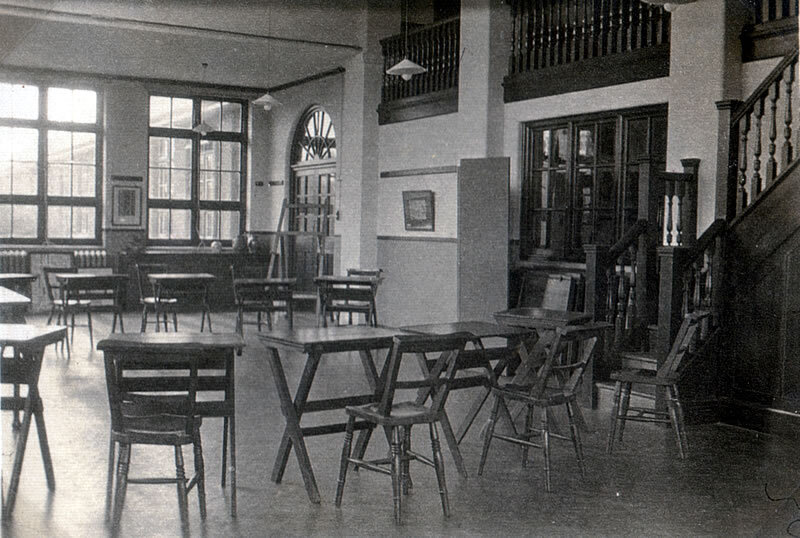
Art room 1927 with picture windows (now science classrooms) 
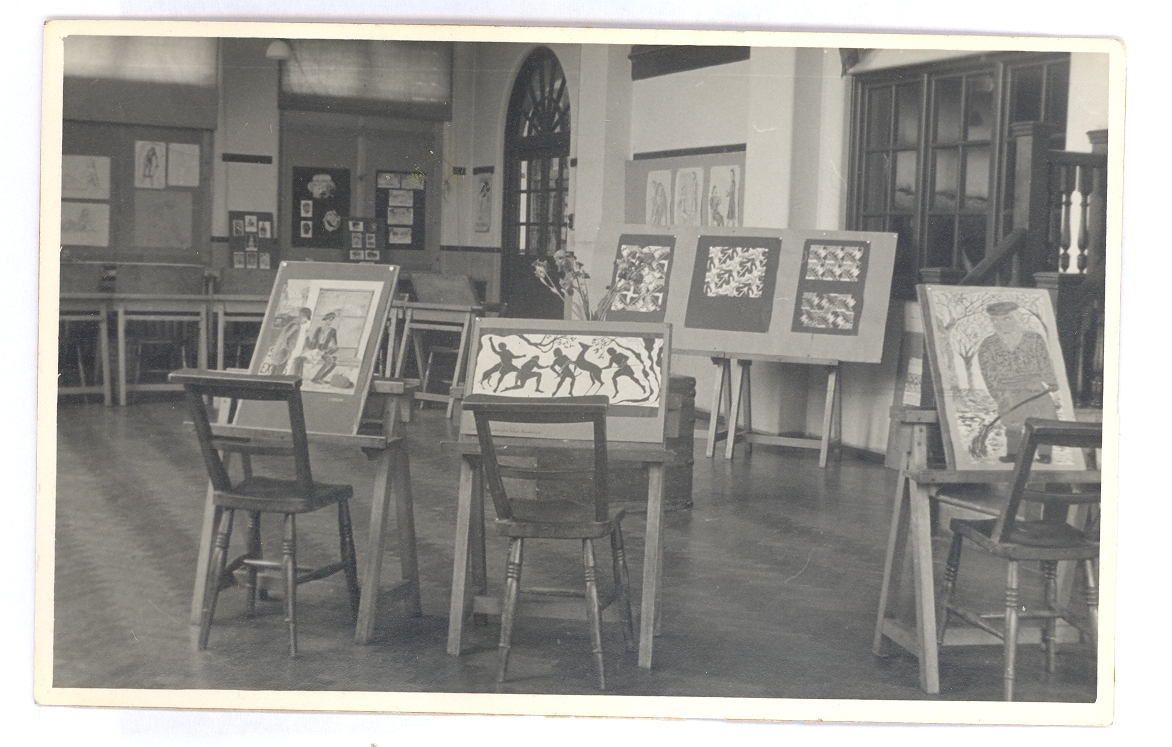
Art room 1946
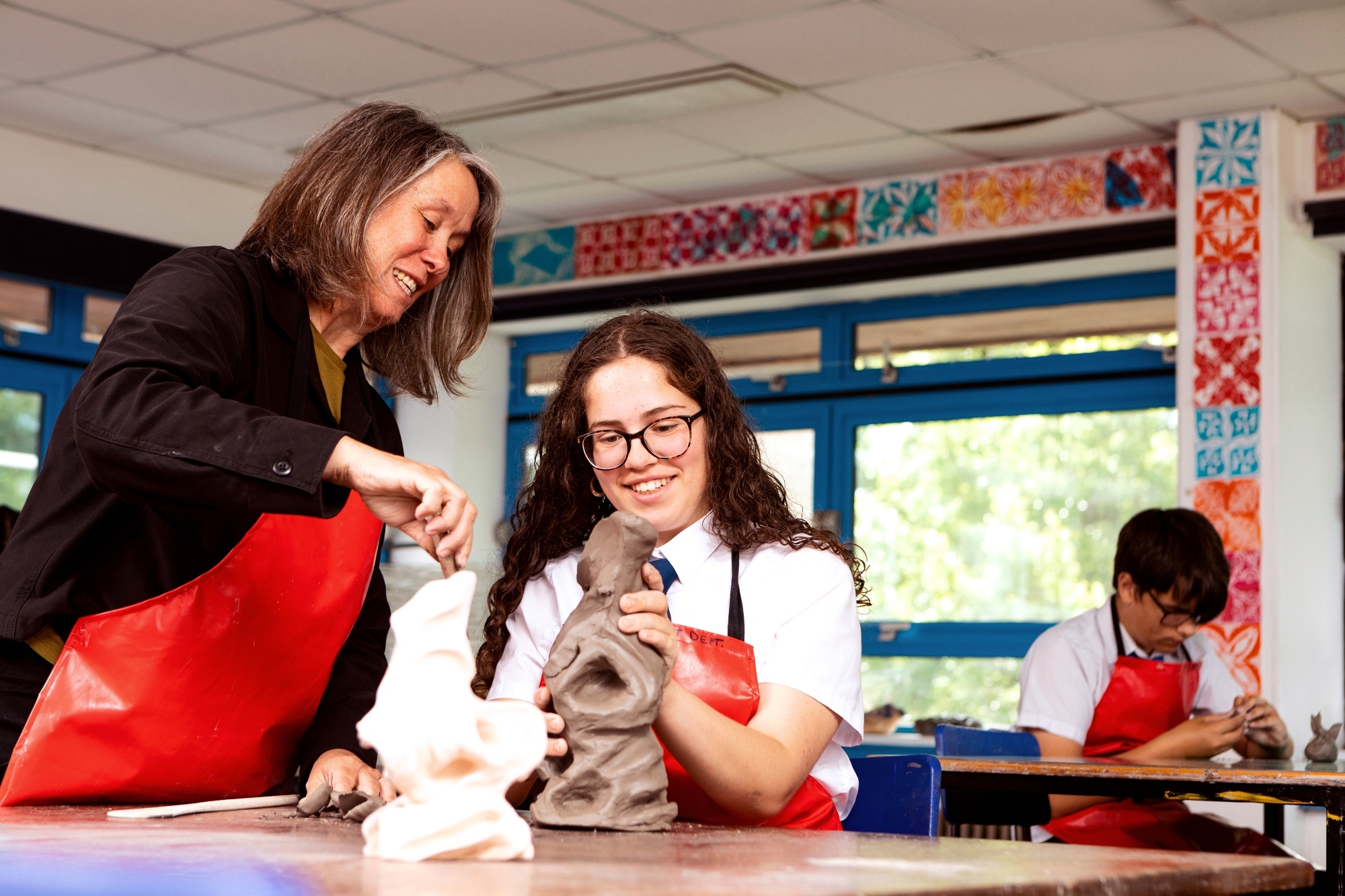
Art Department 2016
Perfection, nothing less
From the laying of the Foundation Stone it took a year and three-quarters to turn a dream into a reality and, on Friday 4th June, 1926, Varndean was formally opened by the Parliamentary Secretary to the Board of Education, the Duchess of Atholl.
Much last-minute work and excitement had preceded the great day. Less than a month before, building work had been paralyzed by the General Strike and the site controller's log which, for nearly two years meticulously records every drawing, brick, pipe, roof-tile and window-frame delivered and put in place, comes to an abrupt halt on 5th May. Nevertheless, ten days before the opening ceremony the move into the new building began. Halls were still being painted and windows being glazed when human chains of girls and staff began passing books and equipment into the Art Room, Library, laboratories and class rooms.
Floors were polished, windows cleaned, pictures hung, desks moved until gradually order was evolved out of chaos and at one o'clock on June 4th the building was not only habitable but beautiful…though but the day before it had seemed impossible we should be ready in time. And how proud we all felt of our building when we surveyed the results of our work and saw what had been accomplished. All was in order, there were flowers in every room, the Library presented an air of scholarly tranquillity. Equally impressive was the Hall with its dignified simplicity, its lightness and loftiness, the copper bowl on the table filled with delphiniums, its beautiful piano. Every room had an atmosphere of tranquil order and the beauty that comes from harmony and simple fitness. We felt a sense of unity, of hope, of responsibility, of pleasurable anticipation, a scarcely defined realisation of the potentialities of the School, a deep sense of gratitude for all that we are now enjoying, a desire to do all we could to serve our generation and show ourselves worthy.
No words but Miss Ellis's own could express the feelings of that day.
It is hard now to realize how great was the impact of this new, elegant and spacious building, widely regarded as the best of its kind in the country, on pupils and staff used for so long to the quaint and cramped buildings of York Place. Perhaps even more impressive was the remote splendour of the site, its wide downland views and its extensive playing fields. At that time the farm, which had occupied the site since Norman times and after which Varndean is named, reached to the school fence at the bottom of the path. There were cows grazing where the Boys' School was yet to be built and farm horses in the barn now used by the groundsmen. There was no transport nearer that the trams at Five Ways and the top of Beaconsfield Villas; the road above Balfour School was only a stony track; there was no Patcham estate, no Hollingbury estate, no Westdene and only a few scattered houses north of the School. At first the grass banks, built when the hockey pitches were flattened, showed more white chalk than grass, the quadrangles were roughened squares trodden down by the builders and the area round the front gate an untidy mass of rubble. Within a year the quadrangles were gardens of beauty and instruction, the southern one being cared for by the Modern Studies Sixth and the northern one a Botanical garden laid out with plants in their natural orders, tended by the Science Sixth. Each form was responsible for the green verge under its form-room windows and, helped by many gifts of shrubs and roses, it soon became a border of varying delights. The space beside the main gate became, under the expert hand of Miss Turner, a rock garden of rare beauty. (Here, girls late out of school on dark winter nights might be lucky enough to peer through her powerful telescope for a first "close-up" view of stars or a full moon.)
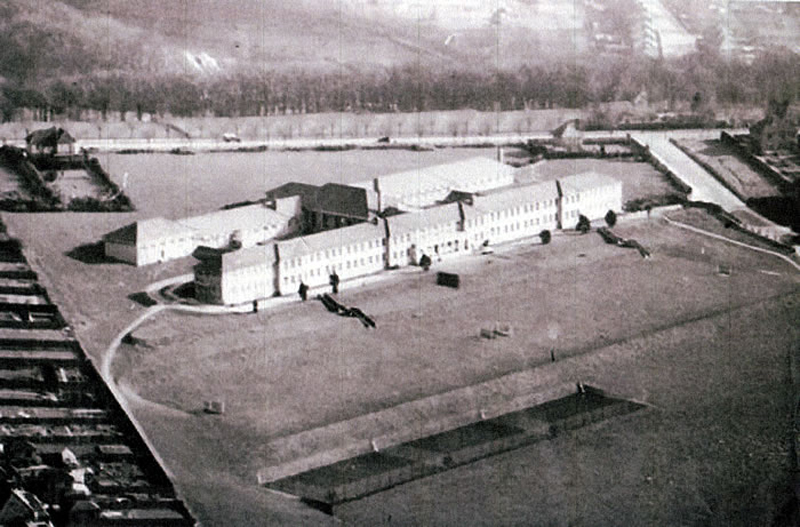
Aerial View 1927
Enormous energy - and many rules - went into the protection and beautification of the School. No-one was allowed to move from the stone-paved cloakrooms on to the fine wooden floors except in rubber-soled slippers, no-one was allowed in form-rooms without a mistress or a prefect present, no-one ran or talked in corridors or carried a school-bag on the wall side - at least in theory! There were form-room tidiness competitions, form-room bulb and flower-growing competitions, anti-litter campaigns. Trophies and prizes were fine pictures rather than cups or shields and the Art room was rich with fine hangings or pottery. Varndean girls were expected to present the same cared-for image in and out of school - outdoors, summer and winter, school hats must be worn and even at the weekend girls were not expected to wear a school-blazer unless the school hat was worn too. Gym. tunics were never to be longer or shorter than "four inches above the floor when kneeling and were measured every term; black stockings were always worn with uniform in winter and, until the 1930s, in summer too. When in uniform girls were expected never to walk more than two abreast in the street, to talk quietly and never to eat sweets or ices.
Nowadays such regulations will sound over-restrictive, but it is important to remember first, that they were not always obeyed - the Disorder Mark system was still in active use - and, more importantly, that Varndean girls were genuinely aware of being privileged young people. The school-leaving age for nearly ninety per cent of schoolchildren was still only fourteen and unlike today, when Varndean is the most antiquated of buildings occupied by Brighton High Schools, it was then alone in having its own playing fields, modern laboratories, library, purpose-built dining room and kitchen and a host of other amenities. The Varndean Chronicles of this period reveal very clearly the sense of pride and purpose shared by staff and pupils inter-acting on each other. "Perfection, nothing less" seems almost palpably attainable.
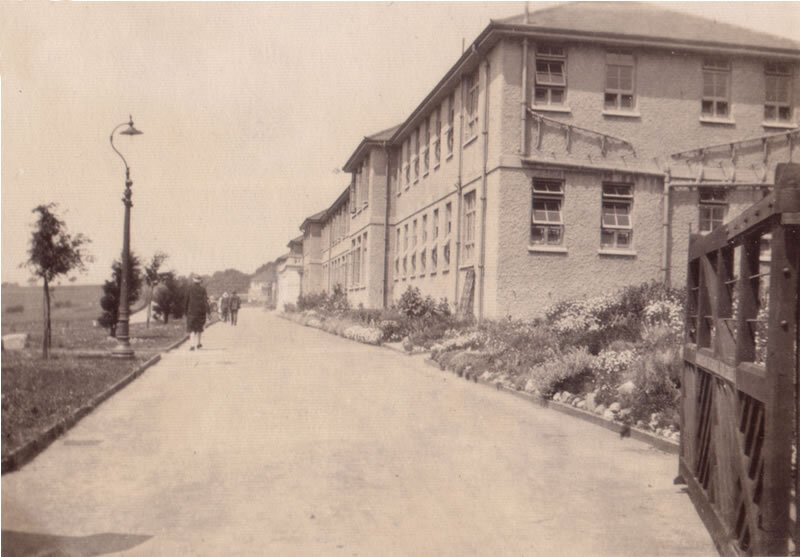
Varndean School 1930
In all the years before 1926, some forty girls had gone on to university. Before Miss Ellis retired in 1937, more than fifty others had joined their number and throughout this time, Varndean was never without an ex-pupil at Oxford or Cambridge as well as others at London, Reading, Manchester and Southampton or colleges of music and art. Fifth and sixth form girls regularly spent a weekend in one of the older universities, entertained and guided by Miss Ellis, Miss Strange and the Varndean undergraduates of the day. Every year, too, a dozen or more Old Girls qualified as teachers whilst others became librarians, bank clerks, nurses, pharmacists, secretaries and journalists. A School Fund, started in 1925 to celebrate the coming move to the new building, aimed to raise £1000 (the present equivalent would be more than ten times as great) to finance an annual Varndean Scholarship of £50. By 1928 a wide variety of fund-raising events, plays, fairs, markets and food-sales ("sponsored" efforts had not yet been thought of) together with generous donations from old girls had raised £800 and the first Varndean Scholarship was awarded to a former school captain who had gained entrance to Cambridge. The Fund soon reached its target, aided by a collection box in every form-room for farthings; and today it still helps, on a smaller relative scale, former Varndean girls at university.
Another much-loved tradition was started when the School's first Varndean anniversary was celebrated in June 1927 by gifts of flowers from every girl in the School to be sent to local hospitals; poems in honour of the new building were read and in the afternoon and a party of boys from the local Dr. Barnado's home arrived to play cricket, run races, eat a huge tea and have their photographs taken. Their ages ranged from six to thirteen and they were "shamelessly spoiled" by their cheerful hostesses. These parties, too, continued for many years. This was not Varndean's only link with Dr. Barnado's. The School had also undertaken to raise £26 a year to pay for the upkeep of one small orphan, Elizabeth, known as "Buffey", and as well as the 4d a term paid by each girl towards this sum. Buffey received annual birthday and Christmas presents, shoes and pretty dresses, letters and much-needed interest from Varndean. In the harsh 1920s and 30s there was so much poverty in Britain that Varndean's gifts were needed at home not abroad, but much happiness was found in preparing the huge displays of dressed dolls and toys which filled the gymnasium before each Christmas under three towering trees donated and decorated by the Fifth and Sixth Forms. Christmas puddings, for which every girl provided ingredients, were made in the then splendidly up-to-date domestic science rooms - two hundred weights of puddings were sent to the miners of South Wales in 1929 - and knitted blankets were made by every form. (The recipients may now be different, but the 1984 list of donations to charity will tell the same generous story.)
The newly-united School revelled in the space of Varndean. Only eighteen of the twenty-two classrooms at the front of the School were needed for forms. There was always room for "divisions" in mathematics and French, a History room which could be blacked-out for the use of slides and the epidiascope, a Prefects' Room. The magnificent Hall encouraged the development of five senior and junior choirs which were regularly successful at the Brighton Musical Festival, annual School plays, Sixth Form plays, Old Girls' plays and staff entertainments; it was also used in wet dinner-hours for "ballroom-dancing" to gramophone records. Others more athletically inclined, could take part in team-games in the gymnasium or practice for the annual gym competition. The splendid games fields made Varndean the venue for inter-school hockey matches and tennis tournaments and once a year, the School held its own special Sports Day. Events which were always particularly enjoyed by a large gathering of parents and friends were the obstacle race, which included a clamber over a straw-filled farm cart from the nearby barns, a dressing-up relay, a flower-pot race and a slow-bicycle race. Until a summer-dress was introduced in 1934, all these activities were carried out in the regulation navy serge tunic, although on one occasion a specially talented high jumper, having won the event on an exceptionally hot afternoon, was allowed to remove her tunic to make an attempt to raise the school record. In an interval between events tea was served to visitors.
Great stability was given to the School by the many long-serving members of staff who were heads of departments, senior form-mistresses and organizers of school societies and who had moved from York Place to Varndean, whilst new energies and ideas came from younger teachers who joined the staff after 1926. Some of these moved on quite quickly but Miss Pierson (1927) and Miss Crocket (1929), later Mrs Bowis, became part of Varndean's special tradition and in 1936 Miss Crocket shared in the organization of the School's first venture overseas. Day expeditions to places of interest, Science Society weekend camps at Nutley and visits to Oxford and Cambridge were long established activities, but the week-long stay in Paris at Easter 1936 was a very special adventure enjoyed by seventeen Fifth and Sixth Form girls on their first visit to a foreign capital. In the same year the School acquired its first wireless set which was used not only to join in such national events as the proclamation of King Edward VIII, but also to enhance French, German, history and music lessons. Also in 1936, the first offer of "school milk" at a half-penny for a third of a pint was taken up by about two hundred girls out of the total school population of over five hundred. The opening of the County Secondary school in Hove during the previous year meant that Varndean lost some of its "out-of-town" pupils, but their places were quickly filled by Brighton girls.
Even as she approached the end of her career, Miss Ellis was constantly ready to experiment and to keep up to date. In 1934 Miss Price had joined the staff and biology was introduced to the school curriculum, whilst the arrival of Miss Everden at the same time led to music becoming an examination subject. There were many minor changes of organization keeping pace with educational developments, but in 1937 Varndean accepted with sadness that Miss Ellis was to retire after twenty-eight momentous years as Headmistress.
When the news became generally realized, tributes of admiration and gratitude were received from her past pupils all over the world. There were those who remembered the "young, dainty figure" of 1909, those who had shared the brave war-time years and those who had taken part in the triumphant move to the new school. All wrote with gratitude of the way her instruction, inspiration and example had enriched their lives with Chaucer, Shakespeare, pictures, flowers and gardens, the love of books and music and concern for "all the good and beauty" in learning and in human relations. Speech Day in July 1937 was the occasion for Governors, Councillors and distinguished guest to pay tribute to an outstanding and much-loved Headmistress, and a few days later Old Girls and former staff added their appreciation of "this exquisite little lady" whose ambitions for the School had been as powerful and, in her own words, "as restless as the sea".
To replace a headmistress of such unique quality must have been a daunting task for the school governors and education authority but in appointing Miss M.P. Warmington they wisely chose a very different but equally enthusiastic and committed teacher and administrator. Miss Warmington was half her predecessor's age, a scientist by training and as much an admirer of the "new world" (she had just returned from a year in the U.S.A.) as Miss Ellis had been of European culture. Even after one year, she was ready to start on a planned change of emphasis in the curriculum and in organization but Varndean was very fortunate in having Miss Strange, now in her own retirement year, to carry the School through the first year of transition "without", as the new headmistress said "too rough a seam".
Miss Strange who also served Varndean for twenty eight years, as Second Mistress, had worked in perfect harness with Miss Ellis, carrying responsibility for day-to-day discipline, organizing the successful history department, helping with every interest from games to the Library and setting the highest standards of work and behaviour. The Debating Society, the Varndean Chronicle, the visits to Oxford and Cambridge, the care of the Sixth Form quadrangle all owed their origin to her and perhaps no-one but Miss Ellis could fully realize the value of her devotion to the School. Her departure, too, was felt with great sadness. She was replaced as Second Mistress for one year by Miss Marshall (retired 1939) and then by Miss Price.
For more information on the school's history please follow the links below:
1939-1974 - York Place to Varndean
1975 to the end of the Millenium
|
Miss Martha Brion 1849 - 1911 |
From (Almost) Rags to (Almost) Riches York Place Headmistress 1884 - 1894 Martha Brion was given responsibility for developing York Place Girls’ School as a Higher Grade school. Under her the school grew in popularity. Numbers rose from 76 to 422 pupils and 3 to 8 teachers. She was credited with running an ‘excellent school’. |
|
Miss Annie Margaret North 1867 – 1958 |
Headmistress of York Place Higher Grade Girls’ School 1894 – 1901 She saw further expansion of the girls’ school, which reached 522 pupils, with 10 teachers. She also oversaw the introduction of an Organised Science School (later called a secondary school). Under her guidance, pupils could stay on until 16 and take public exams for the first time, giving them the opportunity of further education and improved career choices. This was obviously more revolutionary for the girls. |
|
|
York Place Headteacher 1901 - 1909 Laura Hilton faced a major challenge in the school’s development as it moved to the control of Brighton Council as ‘York Place Municipal Secondary School for Girls’. Exam successes continued to rise and the school also became a local hub for teacher training. |
|
Miss Ethel Ellis 1874-1961 |
York Place Headteacher 1909 - 1926 Varndean School Headteacher 1926-1937 A pioneer in many ways. Ethel Ellis was the first University graduate to hold the job at either the Girls’ or the Boys’ School. It was her vision to relocate from the cramped buildings in the polluted town centre to Varndean, which was then on the edge of Brighton. Despite problems, especially World War I, she persevered to get the new school open by 1926. She focused on giving students a rounded education, encouraging not only academic achievement, but also sport and wider interest groups. |
|
|
Headmaster of York Place Boys' School 1884 - 1902 Also an experienced Board School Head, he developed York Place Boy’s Higher Grade School, which also grew in size. He oversaw the introduction of an Organised Science School. |
|
|
Headmaster of York Place and, briefly, Varndean Boys' School 1902 - 1932 William Stainer saw the same transfer to Brighton Council. He also planned the move from York Place to Varndean, though 6 years after the Girls’ School! |
|
Marjory Patience Warmington Head Teacher 1937-1961 |
Head Teacher 1937-1961 Her three key goals were:
|
|
Miss Rhoda A. Clarke Head Teacher 1961 - 1977 |
Head Teacher 1961 - 1977 Her main focus was to improve the academic performance of students and to encourage more to go to university. She worked hard to achieve a smooth transition to mixed,comprehensive education, even though she was not in favour of the move. |
|
Mrs Margaret Smithers Head Teacher 1977 - 1986 |
Head Teacher 1977 - 1986 Used her skills to oversee the development of Varndean as a mixed comprehensive High School. |
|
Pam Bowmaker To the End of the Millennium 1984 - 2000 |
To the End of the Millennium 1984 - 2000 She moved the school towards a more student-orientated community. She was keen on furthering education developments at a local and national level. This also included putting the school forward,successfully, for the recently introduced Technology College status. |
|
Andy Schofield The New Millennium 2000 - 2009 |
The New Millennium 2000 - 2009 Andy Schofield worked to get the school Specialist status. He was also prepared to fight for what he believed was right in both the PFI finance issue and also defending another school which was closing. |
|
Mr William Deighan 2009 - 2021 |
2009 - 2021 William Deighan introduced the smaller school system. |
|
Shelley Baker 2021 - present |
Shelley Baker 2021 - present |
MISS MARJORIE WARMINGTON 1937 - 1961
MISS RHODA CLARKE 1961 - 1977
MRS MARGARET SMITHERS 1977 - 1986
MRS PAMELA BOWMAKER 1986 - 1999
MR ANDY SCHOFIELD 2000 - 2008
MR WILLIAM DEIGHAN 2009 - 2021
School system
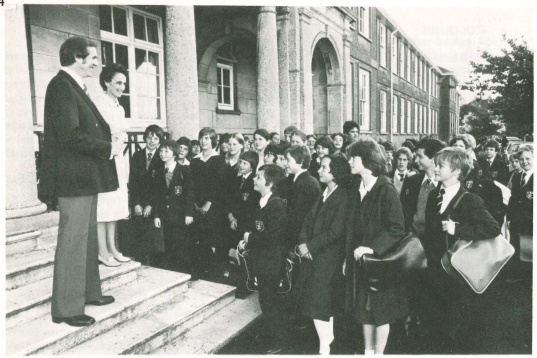
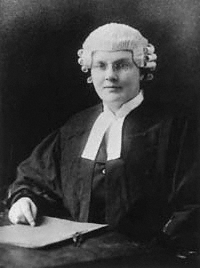 Helena Normanton and the Opening of the bar to women, written by Judith Bourne, examines the contribution of alumna Helena Normanton (York Place 1895 – 1900) to greater female participation in the upper echelons of the law. The author contacted the school for details of her earlier life, when researching the subject.
Helena Normanton and the Opening of the bar to women, written by Judith Bourne, examines the contribution of alumna Helena Normanton (York Place 1895 – 1900) to greater female participation in the upper echelons of the law. The author contacted the school for details of her earlier life, when researching the subject.
Helena had to struggle to get to the bar. She studied as a pupil teacher at York Place and took the required Latin at the boys’ school. Originally refused entrance to the Inns of Court, she was finally accepted by the Middle Temple in 1918.
She became the first woman to actually practise as a barrister at The High Court and The Old Bailey; to be involved in a trial in America; to prosecute in a murder trial; to be elected to the General Bar Council; and, finally, joint 1st, in 1949, to be appointed a KC (equivalent of today’s QC).
In later life, Helena supported the scheme which led to the foundation of Sussex University.
She didn’t forget her old school. At the dinner to celebrate the 21st anniversary of Varndean’s opening, she was a principal speaker,
And, don’t forget, there is a Brighton and Hove single-decker bus named after her – look out for it when you are out and about!
 In October 2021 a Blue Plaque was unveiled at 22 Mecklenburgh Square, Bloomsbury, London, WC1N 2AD in recognition of Helena's work. Headteacher Shelley Baker and Year 11 students Issy and Emily went along to the ceremony to celebrate our former student and learn more about her amazing achievements - an inspiring day for all!
In October 2021 a Blue Plaque was unveiled at 22 Mecklenburgh Square, Bloomsbury, London, WC1N 2AD in recognition of Helena's work. Headteacher Shelley Baker and Year 11 students Issy and Emily went along to the ceremony to celebrate our former student and learn more about her amazing achievements - an inspiring day for all!
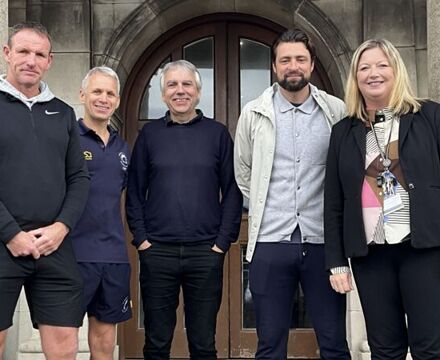 Russell Martin is a professional football manager and former player. He is currently the Manager of Southampton. Russell also founded the Russell Martin Foundation (originally named Russell Martin Academy), a non-profit organisation based in Brighton & Hove, as Russell wanted to give something back to the city in which he was born.
Russell Martin is a professional football manager and former player. He is currently the Manager of Southampton. Russell also founded the Russell Martin Foundation (originally named Russell Martin Academy), a non-profit organisation based in Brighton & Hove, as Russell wanted to give something back to the city in which he was born.
Russell still has strong ties with Varndean School and visits to give inspirational talks to our students.
Lewis is a professional footballer who plays for Brighton & Hove Albion and the England national team. He began his youth career at Wimbledon before joining Brighton & Hove Albion's Academy. He debuted in the (senior) England national squad in 2018.
Varndean School drama student Amita's passion for the performing arts has seen her rise to fame, with roles in Casualty, Ackley Bridge, Doctor Who, The Outpost and more recently she took on the role of Inej Ghafa in the streaming series Shadow and Bone. The cover star of Tatler magazine in April 2023, she talks about her fascinating life story from Nepal to Netflix.
 Tommy Sissons
Tommy SissonsFormer student Tommy Sissons is now a powerful performance poet and writer, as seen in the 'We Are All Stories' series.
On 22nd October, 1924, the Foundation Stone of Varndean School's building was laid.
The Brighton Municipal Secondary School for Girls at York Place was on the brink of moving from it's small original home, to the school's current site on Balfour Road. The move was to bring a new name and numerous advantages to the pupils and staff, notably a spacious new building complete with a hall, gym and dedicated subject rooms, not to mention the expansive playing fields and school grounds.
From the laying of the Foundation Stone it took a year and three-quarters to turn a dream into a reality and, on Friday 4th June, 1926, Varndean School was formally opened by the Parliamentary Secretary to the Board of Education, the Duchess of Atholl.
To mark 100 years of Varndean School on this site we are holding a series of events to commemorate our school community over the years:
Visit to The Keep, 22nd October, 2024
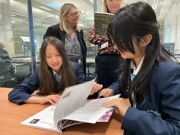
To mark 100 years since the laying of the Foundation Stone we took some students to The Keep, where we looked at photographs, uniform items and some key record books. Many thanks to Andrew and Lynn from The Keep for assisting us. Please see more photos below.
New School Podcast
We are launching a brand new official school podcast featuring past and present connections. If you have any fond memories of your time at Varndean and you would like to feature in the podcast or would like to find out more, please get in touch!
Guest Speakers
If you would like to come in to speak with us and current students, please get in touch.
More events will follow as we approach the anniversary of the opening of Varndean School.